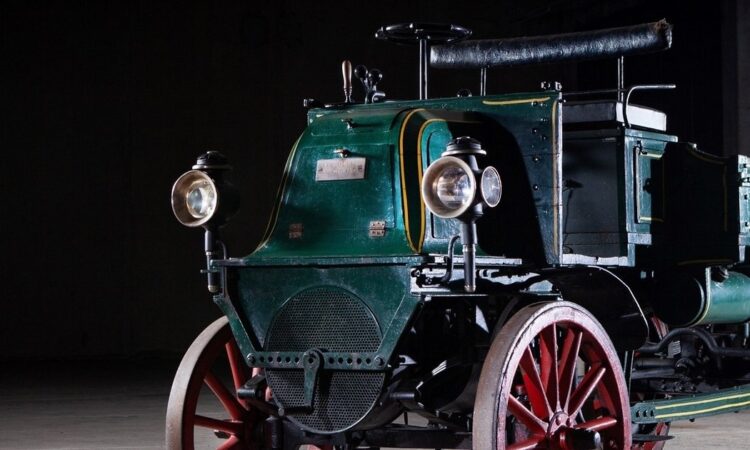Leinfelden-Echterdingen/Wörth – The third version of the world’s first ever truck from 1896 is part of the Mercedes-Benz Trucks Classic Collection. This is the Daimler truck from 1899 with cardan drive, built by Daimler-Motoren-Gesellschaft, Cannstatt.
The truck, which at that time was still running on petrol from the pharmacy, had initially been fired up three years earlier in Cannstatt. The car itself was only 13 years old at the time. Cars and trucks were extremely rare on the roads at the time. Horse-drawn carriages continued to be used to transport people and goods, especially in cities. Freight transport over long distances, however, was handled by rail or ship.
According to the entry made in the ‘Commission Book’ of March 11, 1899, the Daimler cardan-truck from 1899 was delivered to the “Stuttgart Municipal Water Works”, where it loyally served between 1899 and 1923. A photo taken at the underpass near Cannstatt railway station takes us back to that time: In front, on an open cab, sits the chauffeur with a worker standing at the back of the platform. Beside him is a huge vise and next to it, a device for cutting pipes and threads – back then, the essential tools for laying water pipes, which were mostly made of metal.
After 24 years, Stuttgart Water Works replaced the truck with a more recent model and returned it to Daimler-Motoren-Gesellschaft in 1923, where it already became part of the museum’s collection. As the bombing raids intensified in Untertürkheim in 1944, part of the museum’s collection was relocated to Dresden. During the subsequent occupation of Germany and the years before reunification, all attempts to return the vehicle to Stuttgart failed. It was only when the Berlin Wall fell in 1989 that Daimler-Benz AG, as it was then known, managed to strike a deal with the Free State of Saxony in 1991 after two years of negotiations to return 16 historic vehicles, including the Daimler cardan-truck from 1899, to the museum after 63 years. As part of the spin-off of Daimler Truck AG, the vehicle was transferred to the inventory of Mercedes-Benz Trucks Classic where it has been securely housed and looked after ever since.
Visually, the Daimler cardan-truck from 1899 resembles a horse-drawn carriage without a pole, essentially a large liftgate on wooden wheels with a combustion engine. Just three years after the delivery of the first truck, its technology has already been significantly developed and is still relevant today in its basic features. Unlike the first and second motorized trucks, the drive of the 1899 Daimler cardan-truck was no longer installed at the rear or on the vehicle frame underneath the cab, as this proved impractical when loading from the rear. Instead, it was placed in the front of the vehicle over the front axle. The truck was now steered using a steering gear instead of chains. The power transmission using pinions in the wheel anticipated the modern planetary hub reduction axle. Features which were state of the art for 1899 included efficient engine cooling using a tubular radiator and brakes that act on both rear wheels, as well as on the reduction gearbox. Having brakes solely on the rear axle would remain commonplace for many years to come.
In the sales brochure of the time, the Daimler cardan-truck from 1899 was offered with “2 or 4-cylinder engine” and now also with “electric ignition”. The conventional “hot-tube ignition,” which was ignited using wood shavings, often had the side effect of blackening the driver’s face, thus obscuring visibility. Outputs on these commercial and delivery vehicles ranged from 4, 6, 8, 10, to 12 horsepower. The payload capacities of the vehicles were given as 1.550, 2.500, 3.750 and 5.000 kilograms. “The wheels are fitted with iron tires”, reads the description. On the cobblestones that were common at the time, the noise was enormous.
Brummionline


